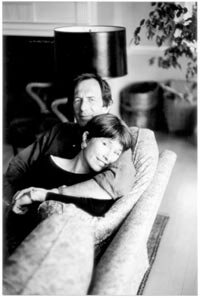'Larger than life': Double loss leaves community grieving
As 2004 came to an end many holiday festivities in Charlottesville were tempered with sadness following the deaths of R.B. Smith and Karen Silverman. While any loss is difficult, the deaths of Smith and Silverman, both integral members of the local arts community, made particularly large ripples across Charlottesville.
As Live Arts director John Gibson recalls, "They were larger than life."
KAREN SHEA SILVERMAN
Though she died on December 19 at age 62 following a two-year battle with cancer, friends say Silverman will live on in their hearts and minds, but also through her art.
"She had an incredible gift," says artist Asha Greer, who calls Silverman, who painted under the name Karen Shea, a "mentor." Greer and Silverman met when both lived in an arts community in Batesville in the 1960s.
Silverman, mother of two daughters, Kia and Taije, had a profound effect on everyone in the community, says Greer, but particularly on children.
"She could make anyone she was talking to feel that they were the most important person on the entire planet," says Greer. "Not only was she beautiful; she made beauty everywhere she went."
Gibson agrees. "She was the most beautiful woman in Charlottesville," says Gibson, not only because of her physical attributes but also because of her "elan and spark."
Silverman, he adds, was a tireless supporter of the arts in all forms. When her husband, developer Gabe Silverman, leased the Old Michie building space to Live Arts back in 1990, Gibson says it was a "leap of faith." Silverman, who served on Live Arts board from its inception until her death, "was inseparable from that leap of faith," Gibson says.
"Her studio was upstairs," he recalls of Live Arts' early years, "and it was a rare day that didn't include a visit or a chance meeting or Karen poking in the back door just to see what was going on with encouragement and delight and a palpable sense of belief– of faith."
Her love of the arts, coupled with her "deep spirituality," also explain her decision in the mid-1960s to start the first art school for black children in Apartheid-torn South Africa, says Gibson.
"That was a great expression of who she was," he says, "that she found her calling as a teacher of art."
Forty years later, her effect on students remained powerful, says Tim Michel, one of Silverman's longtime painting students. His teacher, he says, taught him much more than technique.
"Karen taught me that a painter's black isn't a pure, solid negative color, but it is always made up of all the other colors," says Michel. "She went on to show me that what is true of black pigment is equally true in life. The darks hold the full spectrum of colors in them if you look for them."
A memorial service for Silverman will be held at Live Arts in January.
R.B. SMITH
While friends are still coming to terms with the unexpected death of 57-year-old R.B. Smith on November 24 from a heart attack, their memories of him often bring a smile.
"When he asked how you were doing, he really expected an answer," recalls Howard Pape, who first met Smith 25 years ago when Smith worked for him as a carpenter.
"He was unbelievably compassionate and empathetic," says Pape, who says the friendship continued long after Smith had left his employ.
Married for 10 years to Live Arts founder Fran Sackett-Smith, Smith was a regular presence at the theater. Live Arts director John Gibson calls Smith "secret glue" in Charlottesville.
His wide-ranging interests and talents– from carpentry to music to politics– brought together people who Gibson says "might never otherwise have met."
His charm and enthusiasm were infectious, Gibson adds, recalling, among other things, the many theatrical sets Smith built for Live Arts.
"He was a bon vivant, and a boulevardier," says Gibson. "He connected people, went from place to place, was never too busy to stop and chat on the sidewalk."
Particularly if you were a musician whose work Smith appreciated. "If he was a fan of your music," says Gibson, "then he shared that, and shared it ferociously with enormous energy."
Singer/songwriter Paul Curreri felt Smith's support firsthand. In addition to offering to finance Curreri's most recent album, Smith had given him a photograph of an old pair of his boots.
Below the picture, he'd written: "Paul, Go on with your boot-ass masterpiecing, Love R.B. & Fran."
"R.B.," says Curreri, "had a habit of glowing over folks, talking real close and deep, and eventually, it kinda seemed like it was the folks doing the glowing."
His support of others was not limited to their artistic enterprises, however.
Several friends mention Smith's devotion to helping people through 12-step recovery programs.
"He was a constant presence at those meetings and encouraged so many people to help them down that path," says Gibson.
R.B. wasn't proselytizing; he knew the ropes. He'd led a "wild life," says Gibson, who recalls seeing pictures of Smith "looking like the ultimate hell's angel guy. Really tough."
But the truth, says Gibson, was far from it. "He was just a Santa Claus, such a teddy bear. He was warm and sentimental, and also very realistic. There was no bullsh** with R.B. He said exactly what he thought; that's also something rare enough to merit appreciation."
 "The love of Gabe and Karen was mighty and infectious," says Gibson. "They took such delight in one another."
"The love of Gabe and Karen was mighty and infectious," says Gibson. "They took such delight in one another."
PHOTO BY MARY MOTLEY KALERGIS

"He was the love of my life," says Fran Sackett Smith of her husband R.B. "We only had each other for 10 years."
PHOTO BY JEN FARIELLO
#